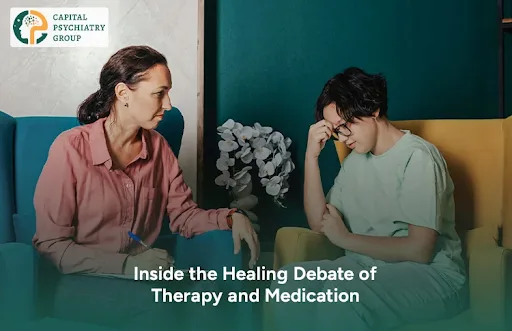Inside the Healing Debate of Therapy and Medication
There’s a reason first appointments feel so different depending on the door you walk through. Some doors lead to a therapist’s quiet room, a place built for words, patterns, and meaning. Others are open to a prescriber’s careful questions about sleep, appetite, energy, and safety, where biology is center stage. Both doors are Mental Health Services, and the debate between therapy and medication is less a boxing match and more a duet. The art is knowing which voice should lead, and when.
A useful way to read this debate is to imagine a dimmer switch instead of an on–off button. Sometimes we turn up therapy: skills, insight, and relationships. Sometimes we turn up medication: neurochemistry, relief, stabilization. Most people benefit from both at different points, and the smartest path is the one that changes with you.
What Therapy Actually Does And Why It Works?
Therapy is often described as “talk,” but its engine is structured change. Cognitive techniques challenge distorted thinking; behavioral methods shape habits and exposure; psychodynamic or trauma‑informed work links past patterns to present reactions. In healthcare services, good therapy is not a motivational speech. It’s a collaborative method with goals, session plans, and measurable outcomes.
Therapy helps when you need:
- Skills to regulate panic, intrusive thoughts, or rumination.
- Practice to face feared situations without retreating.
- Context to name grief, shame, or family patterns that keep replaying.
- Accountability so the hard work happens between sessions.
In research, therapies like CBT, ACT, exposure therapy, and trauma‑focused approaches repeatedly show strong, durable outcomes for anxiety disorders, depression (especially mild to moderate), OCD, PTSD, and insomnia. Therapy teaches your brain to self‑correct and stay corrected.
What Medication Actually Does (And Why It Works)
Medication is not a shortcut; it is a lever. Antidepressants modulate serotonin, norepinephrine, and dopamine signaling; mood stabilizers reduce volatility; anxiolytics quiet acute surges; stimulant and non‑stimulant medications sharpen attention and executive function.
The right prescription can lower symptom intensity enough that therapy becomes possible, like reducing the volume of an alarm so you can find the exit.
Medication helps when you need:
- Stabilization for severe depression, mania, psychosis, or debilitating anxiety.
- Speed when sleep, appetite, or safety are at risk.
- Sustained bandwidth to engage with therapy or daily life without constant overload.
Evidence consistently supports pharmacotherapy for moderate to severe depression, bipolar spectrum conditions, psychotic disorders, OCD, panic disorder, ADHD, and when there is high physiologic arousal that blocks psychological work.
The False Binary of Therapy vs Medication
The most honest answer to Therapy vs Medication about which is better is neither, until we know the person. Some conditions respond similarly to therapy and meds; others clearly favor one. Many respond best to the combination.
Think of a sprained ankle: rest and ice help, but a brace and physical therapy together get you walking sooner and with fewer setbacks. In mental health, the combined model often shortens the time to response and reduces relapse risk, particularly for recurrent depression, OCD, and certain anxiety disorders.
Three practical patterns emerge:
- Start With Therapy when symptoms are mild to moderate, functioning is mostly intact, and motivation is strong. Add medication if progress stalls or stressors amplify.
- Start With Medication when symptoms are severe, dangerous, or rapidly escalating, when sleep and appetite are collapsing, or when a biologic driver is likely (postpartum onset, bipolar spectrum, psychosis).
- Start Together when both domains are clearly active, with significant symptoms and entrenched patterns, so relief and learning can run in parallel.
Choosing Care Under the Banner of Health Care Services
Within the wider landscape of Health Care Services, mental health care works best when it is coordinated. That means your therapist, your prescriber, and (when relevant) your primary care clinician exchange enough information to keep treatment coherent.
Great coordination prevents medication mismatches, duplicated efforts, and “lost in the system” moments that discourage people from staying in care.
Here’s what coordinated care looks like in practice:
- A clear assessment that names the problem, the severity, and the short‑term safety plan.
- A stepped treatment plan that states whether therapy, medication, or both will be first line, and how the plan will change based on response at 4, 8, and 12 weeks.
- Measured outcomes using simple, validated tools (PHQ‑9, GAD‑7, PCL‑5, Yale‑Brown for OCD) to track whether symptoms are actually moving.
- One point of contact, so you don’t have to retell your story to every clinician.
When you interview clinics, ask how they coordinate. If the answer is vague, keep looking.
How Decisions Get Made
Case 1: The Disappearing Morning. Panic attacks have started on waking, with chest tightness and a fear of fainting. Work attendance is dropping. A combined plan might begin with an SSRI to reduce the alarm volume and weekly CBT with interoceptive exposure to retrain the body’s fear response. As panic abates, therapy can taper; medication may continue for a season and then slowly step down.
Case 2: The Heavy Quilt. Depression has layered itself over everything: sleep inverted, appetite low, concentration thin, and self‑criticism sharp. If passive death wishes appear, pharmacotherapy should lead, with therapy joining as energy returns. Behavioral activation and cognitive restructuring anchor recovery while medication shores up neurochemical footing.
Case 3: The Stuck Wheel. Intrusive contamination images drive repeated washing and checking. Here, exposure and response prevention (a specific form of therapy) is first line; medication like an SSRI at a therapeutic dose often boosts gains. Precision matters: the exposure plan is graded, collaborative, and data‑tracked.
Safety, Side Effects, and How to Decide
Every effective treatment has risks. With medication, side effects can include GI upset, sleep changes, sexual side effects, activation, or weight changes; most are manageable with dose titration, timing adjustments, or switching within class. With therapy, the “side effects” are usually effort‑based: temporary discomfort as you face avoided memories, social exposures that raise anxiety before they relieve it, or delayed payoff that asks for persistence.
A good decision process is simple:
- Name the goal (symptom relief, relapse prevention, trauma processing, attention support).
- Estimate severity and urgency.
- Pick the starting lane (therapy, medication, or both) and a specific method.
- Time‑box the experiment, for example, 6 to 12 weeks, and measure.
- Adjust based on data, not frustration.
Remember: changing course is not failure; it is treatment literacy.
Where a Mental Health Clinic Fits
A well‑run Mental Health Clinic balances access with depth. Access means short wait times, same‑day or next‑day triage for urgent needs, and telepsychiatry options when travel or stigma are barriers.
Depth means clinicians who can deliver evidence‑based therapies, manage complex medication regimens thoughtfully, coordinate with primary care, and escalate appropriately when risk rises.
When evaluating clinics, look for:
- Credentials and scope are clearly listed.
- Insurance transparency and practical self‑pay options.
- Outcome tracking posted or explained without jargon.
- A continuity plan that covers vacations, refills, and after‑hours questions.
The Combination Advantage, Without Hype
People are understandably wary of being “over‑treated.” The aim is not more interventions; it is the right interventions at the right time. The combined approach is not mandatory; it is available.
Strategic pairing, skills from therapy with stabilization from medication, can reduce hospitalizations, shorten episodes, and improve function at work, school, and home. That is not marketing; it’s the pattern clinicians see when care is aligned.
How to Talk to Your Clinician About Preference and Fear
Be candid. If you’re drawn to therapy but wary of medication, say so. If you want medication relief but have limited time for weekly sessions, say that too. Your preferences help shape a plan you’ll actually follow. Ask these questions:
- What is your working diagnosis, and how certain are you?
- If we start with therapy, what outcomes should we see by week 6?
- If we start with medication, what benefits and side effects should we expect by week 4?
- When would you add the other modality?
- How will we measure progress objectively?
A clinician who welcomes these questions is signaling partnership, not paternalism.
Cost, Access, and Practical Steps
Finances matter. Many clinics accept commercial insurance and Medicaid; others offer sliding‑scale therapy or collaborative care models where primary care and psychiatry share the load.
Telehealth can reduce indirect costs, no commute, no time off work, no childcare scramble. If cost is a barrier, ask explicitly about generics, 90‑day prescriptions, group therapy formats, or brief‑intervention models that target the highest‑yield skills first.
Practical next steps:
- Book an evaluation and arrive with a written symptom timeline.
- List prior treatments, what helped, what didn’t, and why you stopped.
- Identify one life area you want back (sleep, school, relationship, work).
- Agree on a check‑in metric and a time frame to reassess.
The Takeaway on Therapy vs Medication
You don’t have to pick a permanent team. Start where the evidence and your needs intersect. Let severity, urgency, and preference guide your opening move; let outcomes guide the next. Therapy builds durable change; medication creates conditions where change is possible, and sometimes prevents catastrophe while you build the rest.
The real debate isn’t therapy or medication. It’s whether we’ll choose with clarity, track our progress honestly, and adapt without ego. Do that, and your plan, whatever its mix, will be the right one for now.




